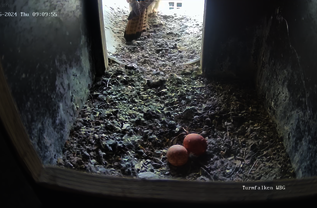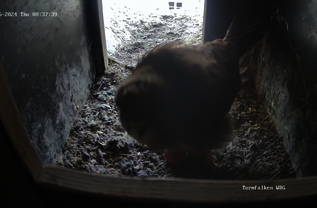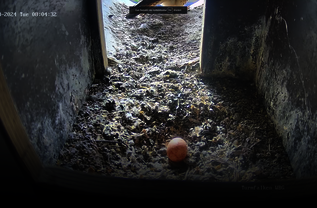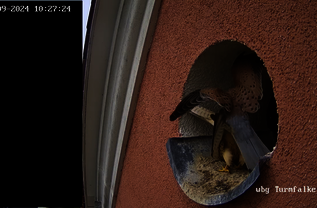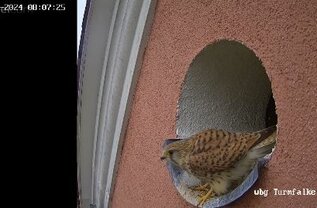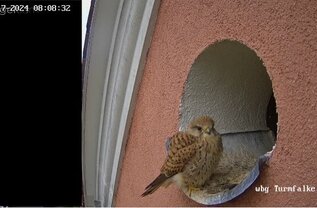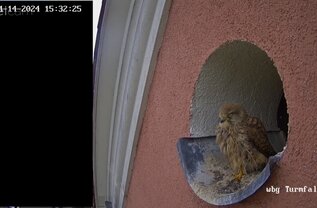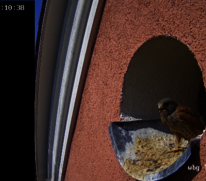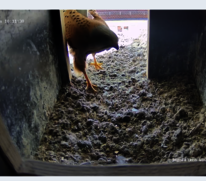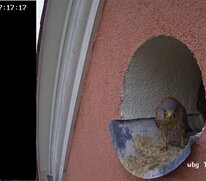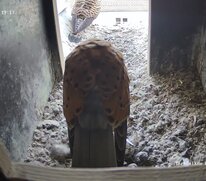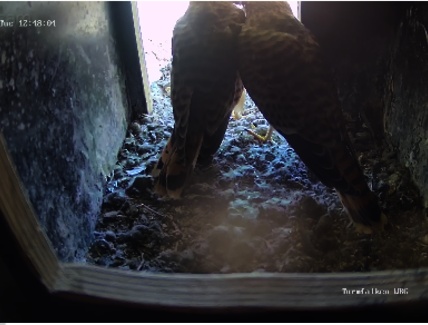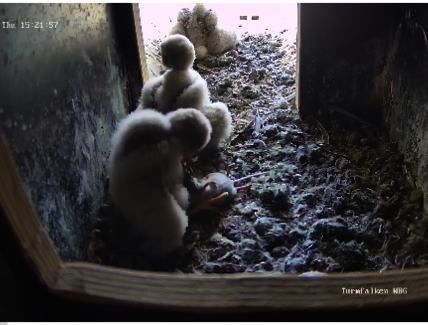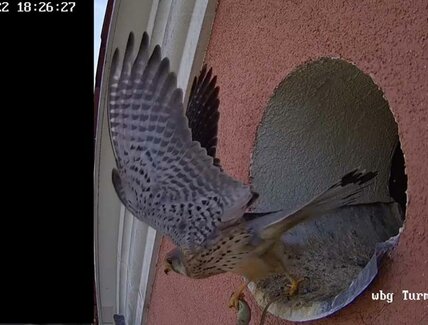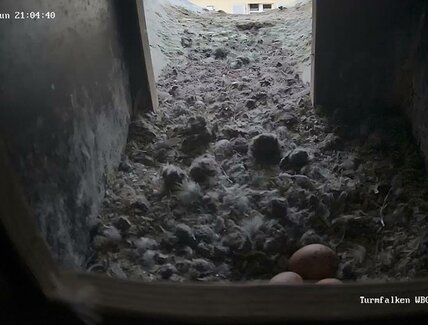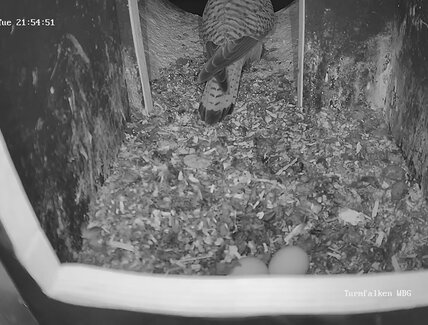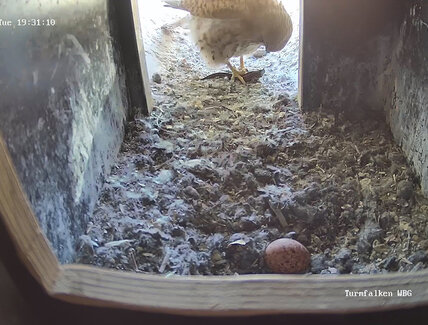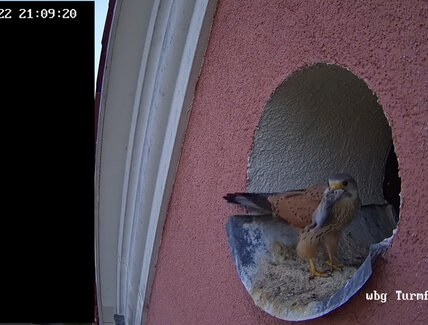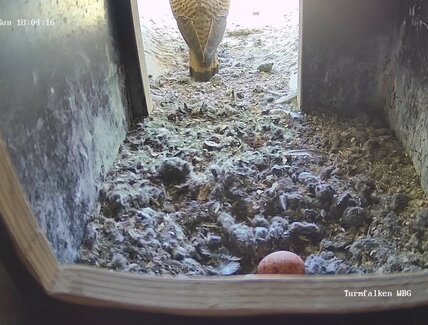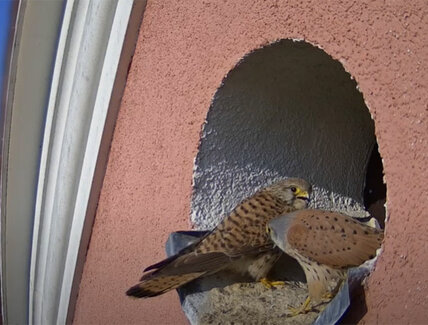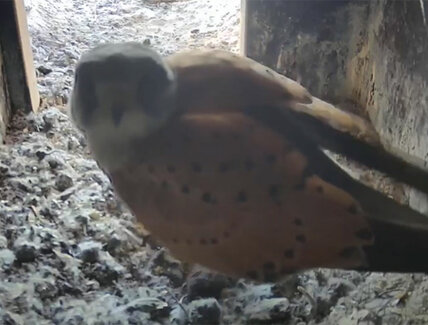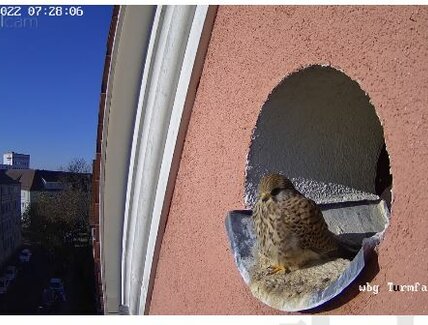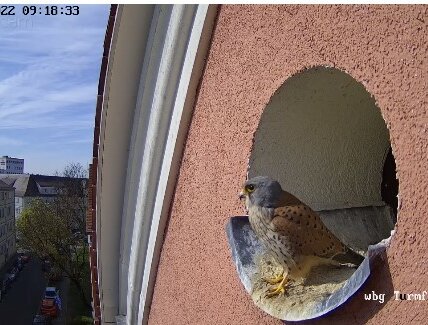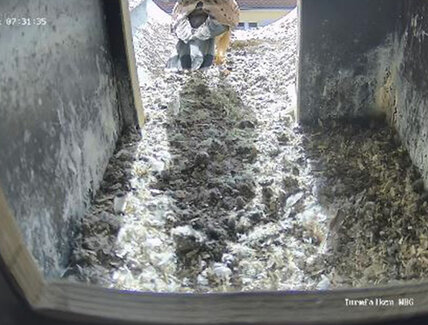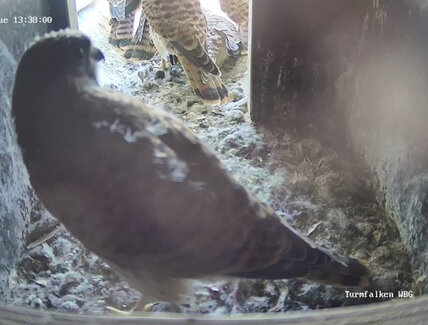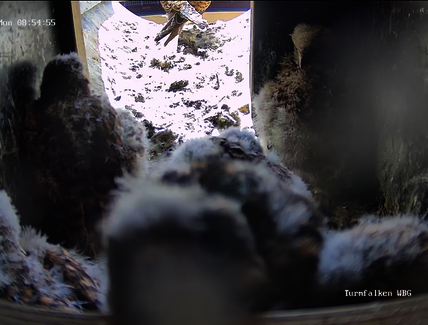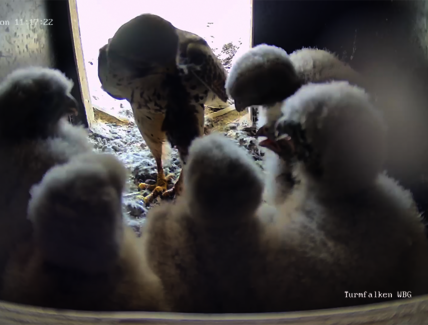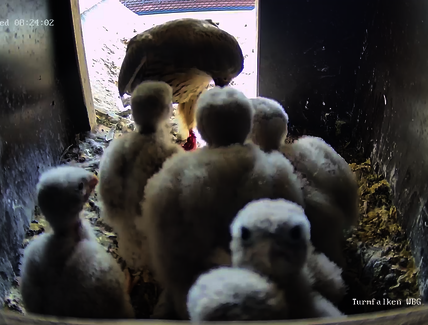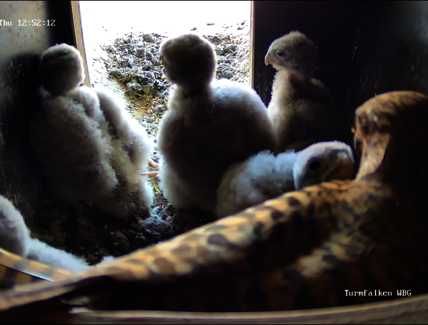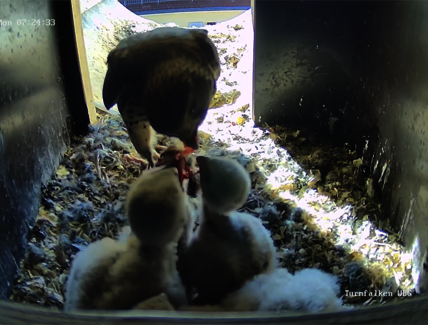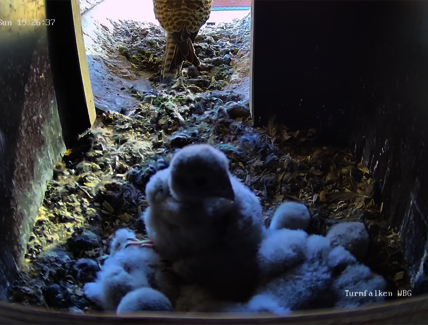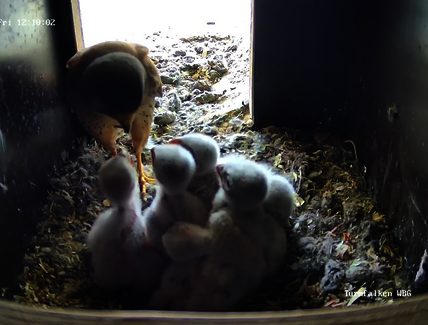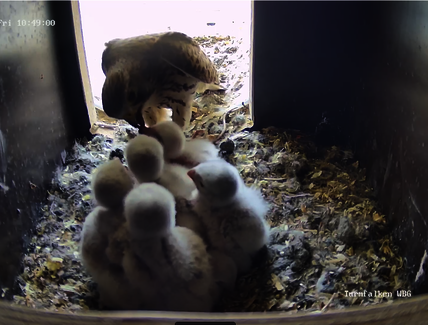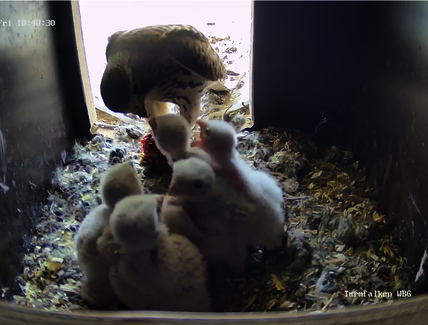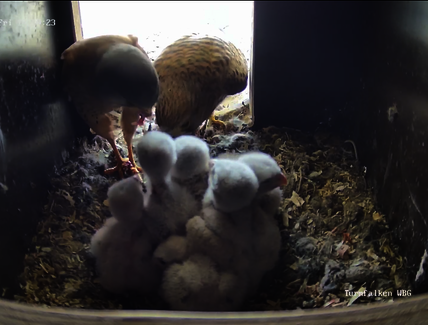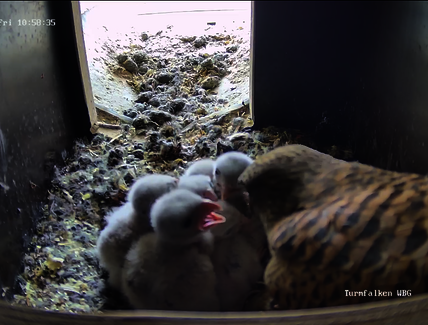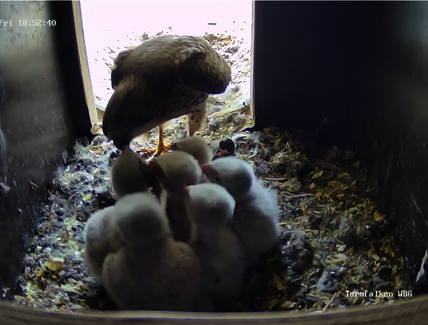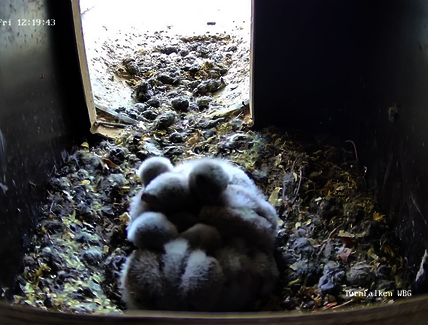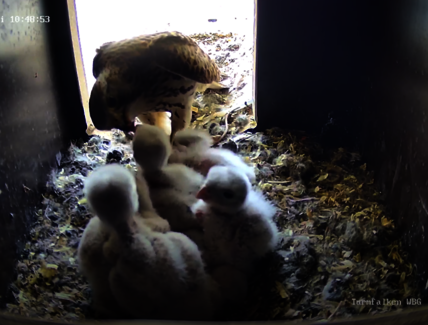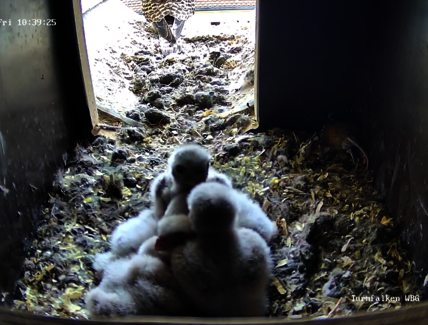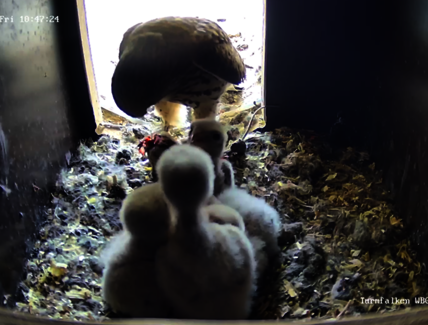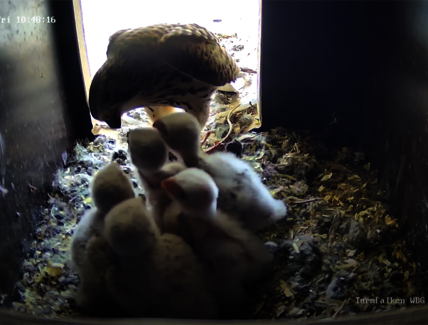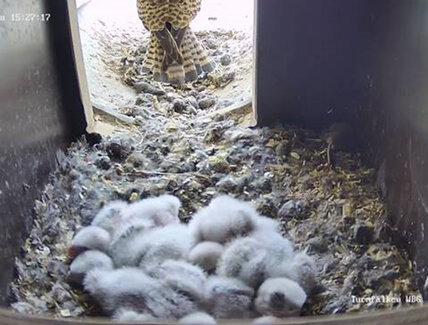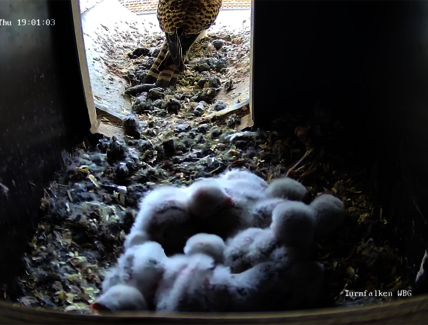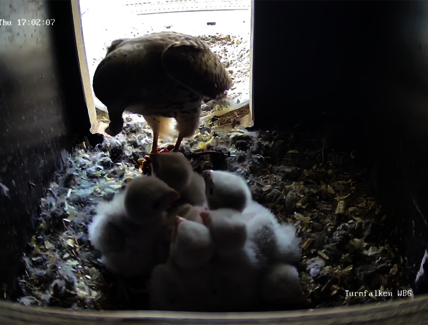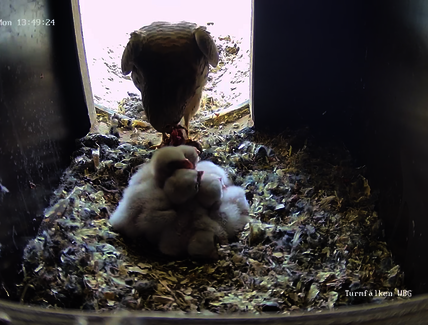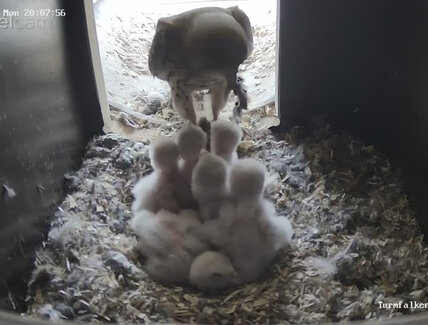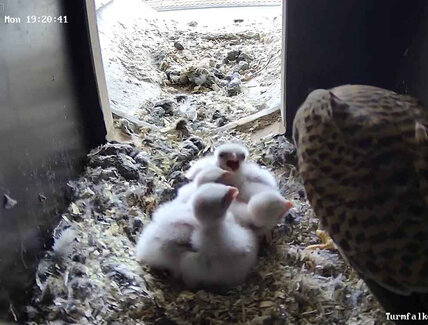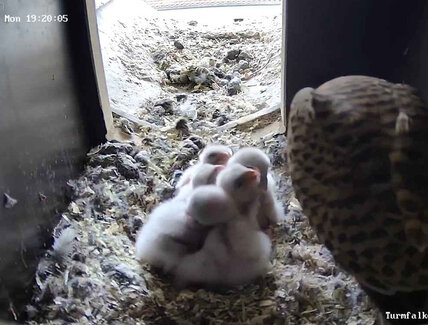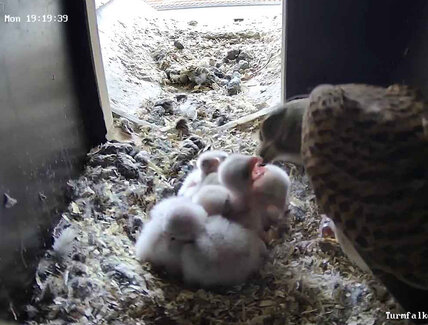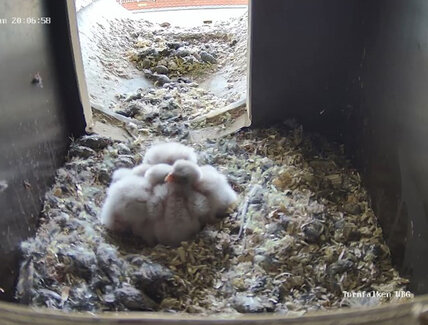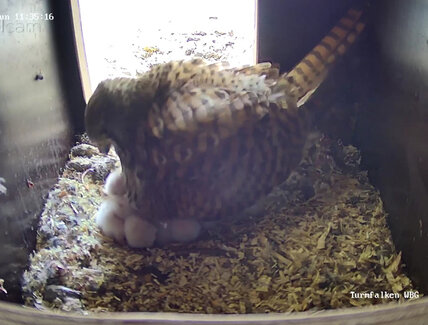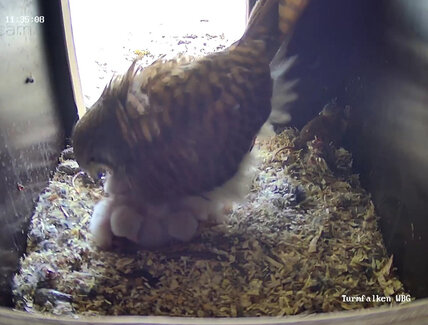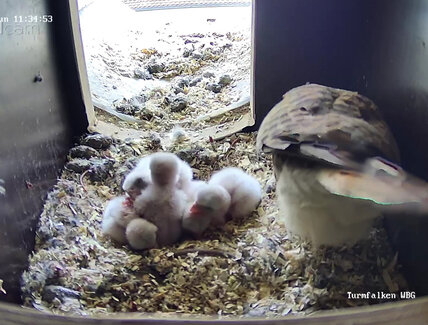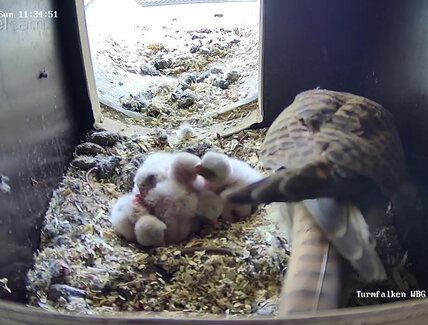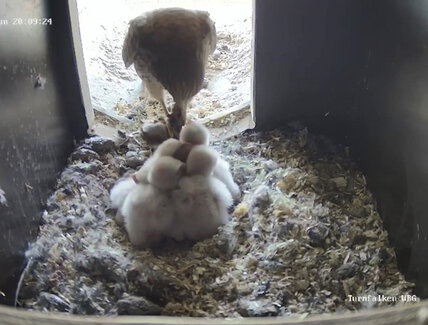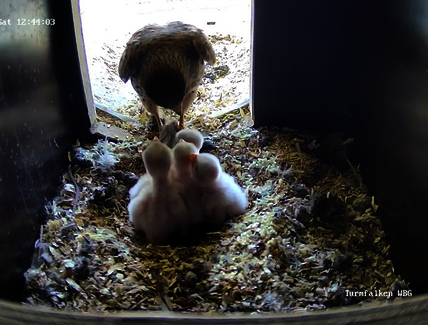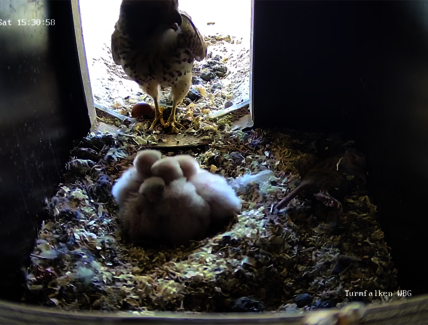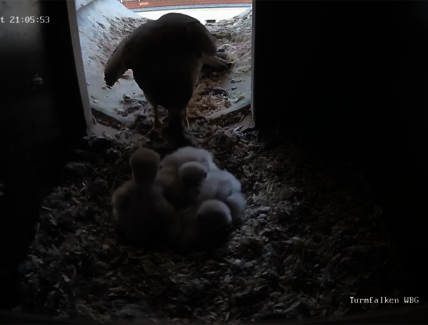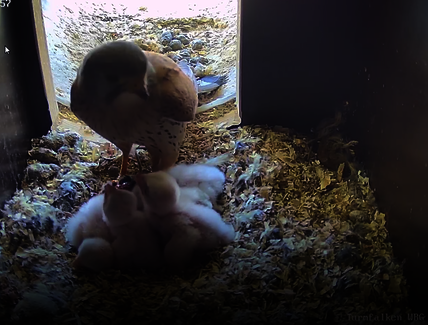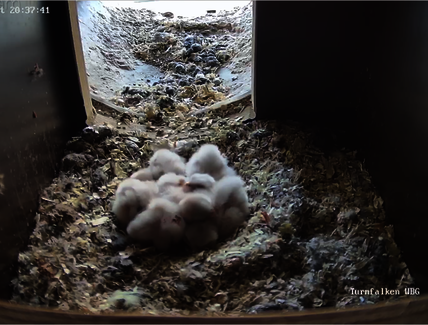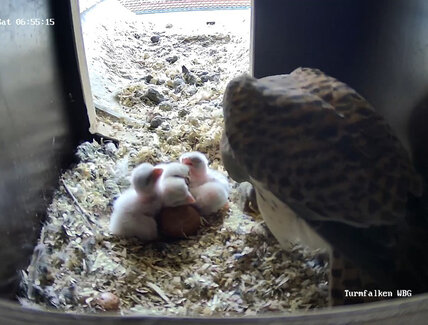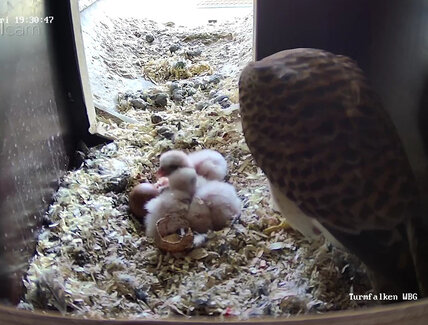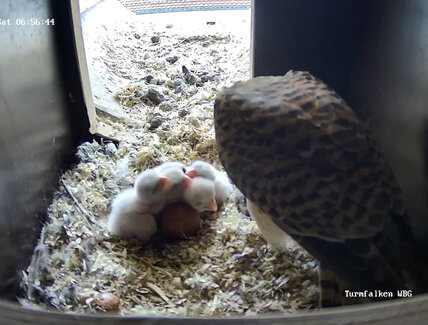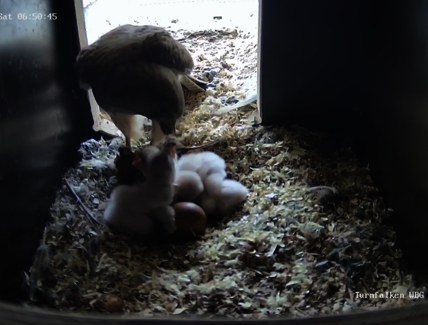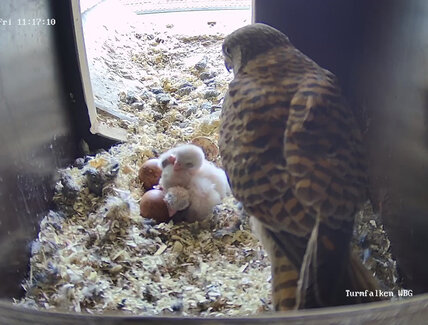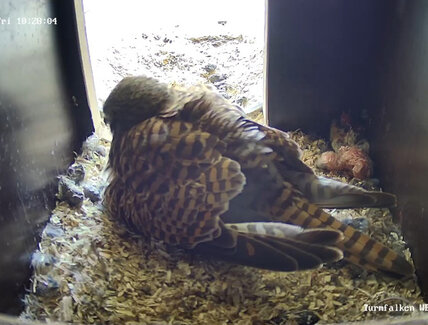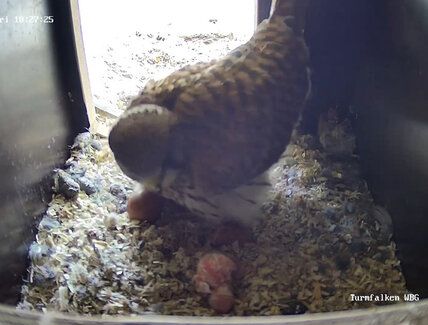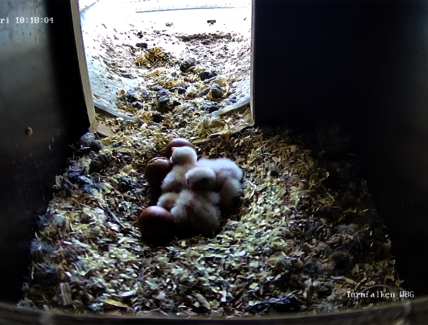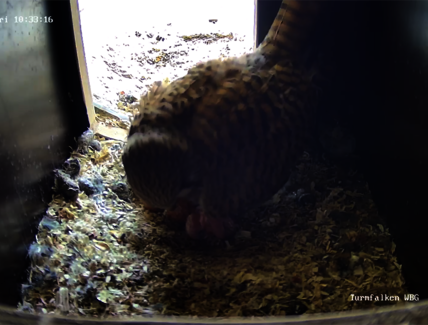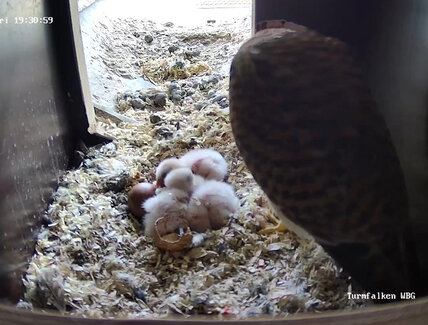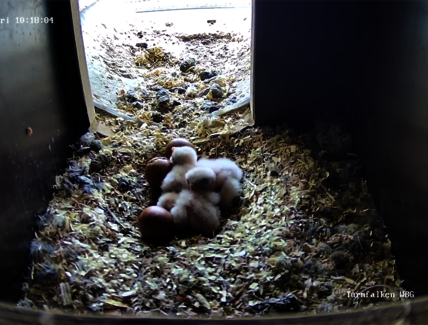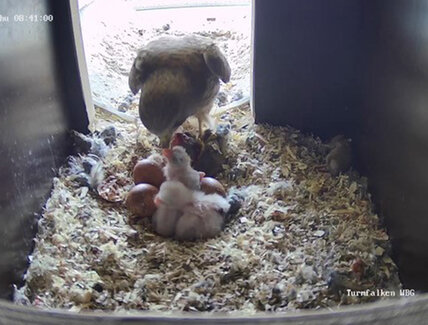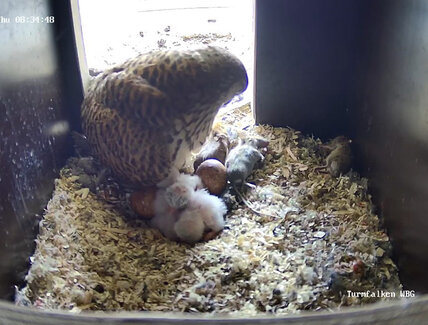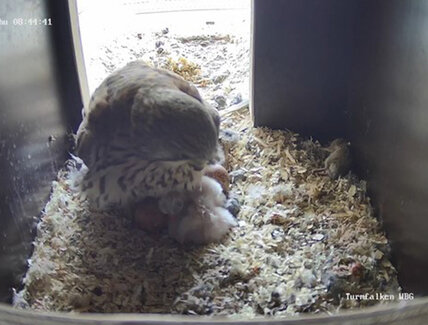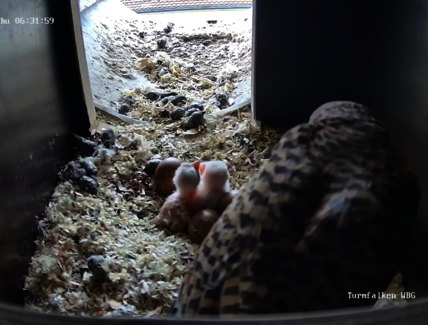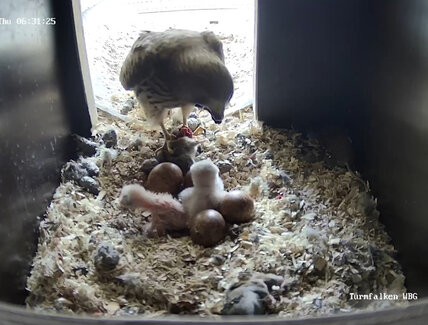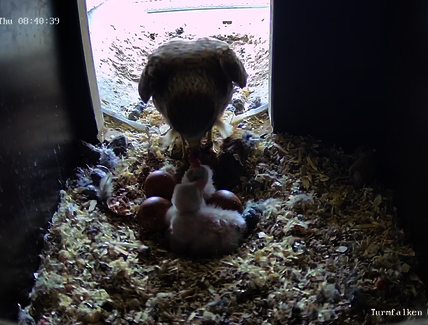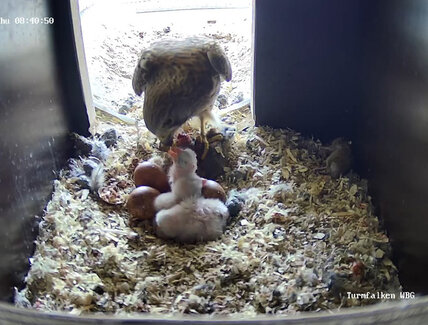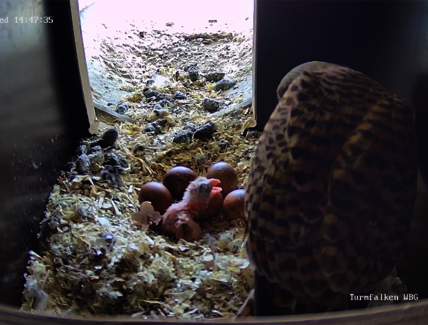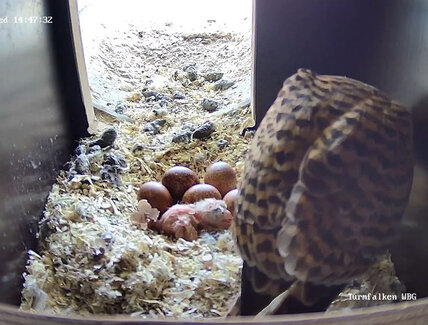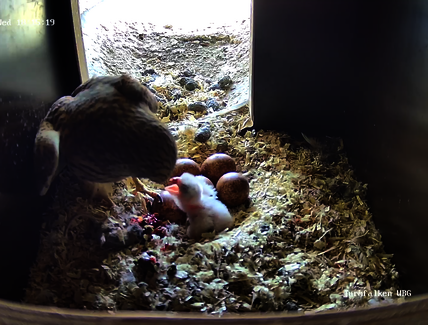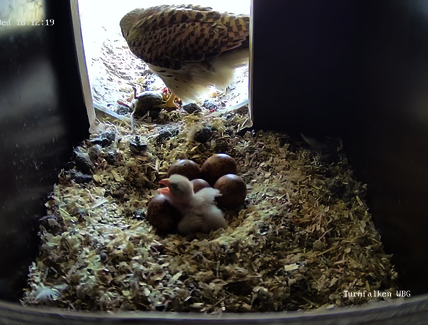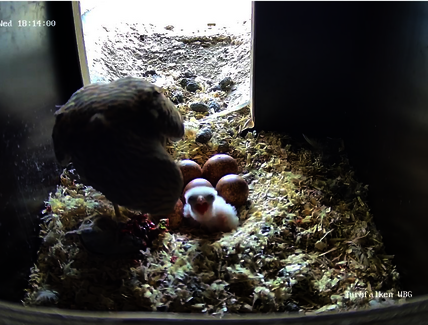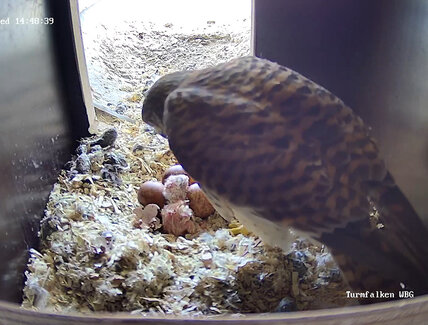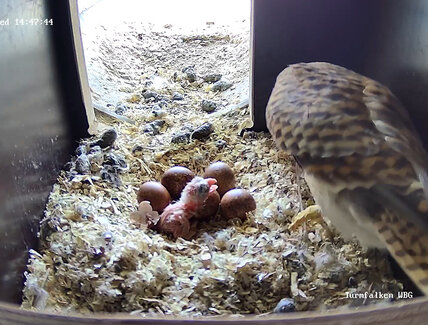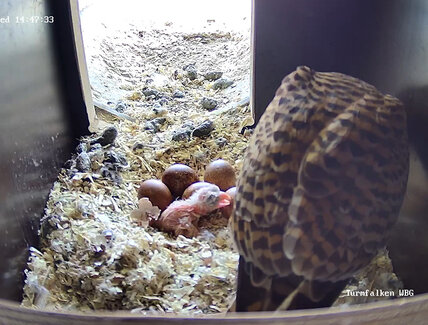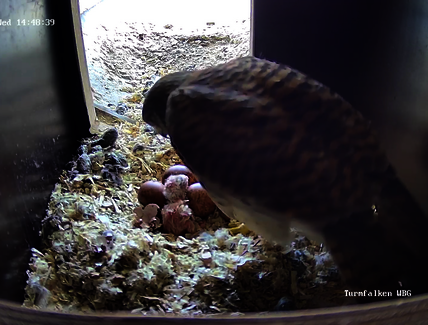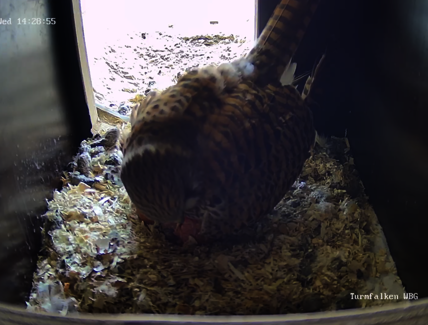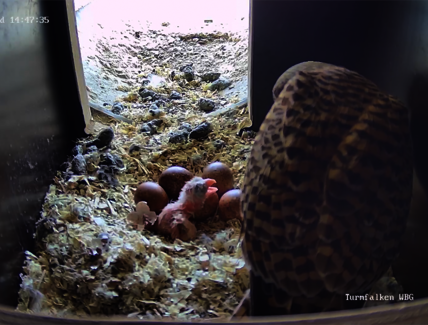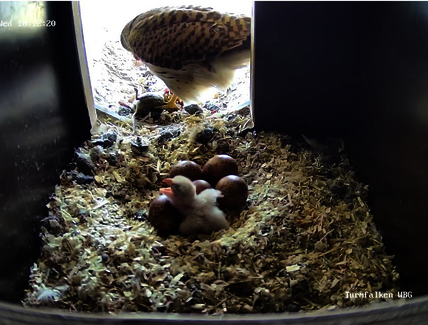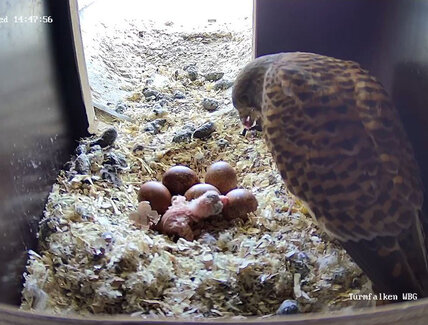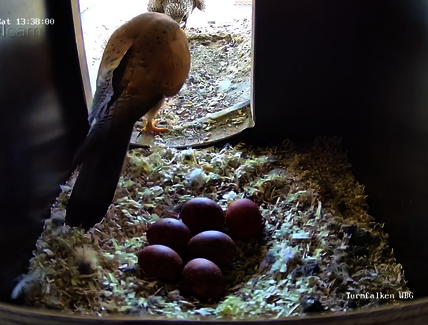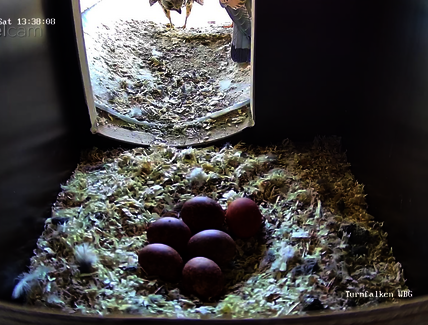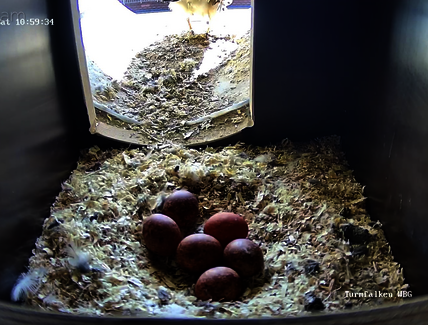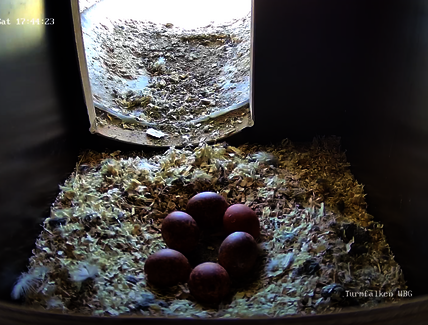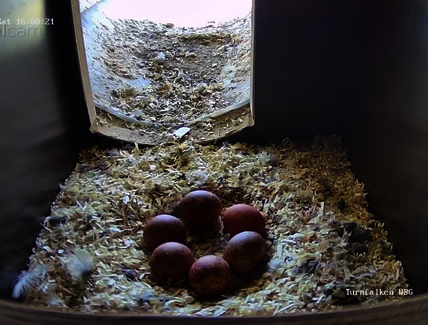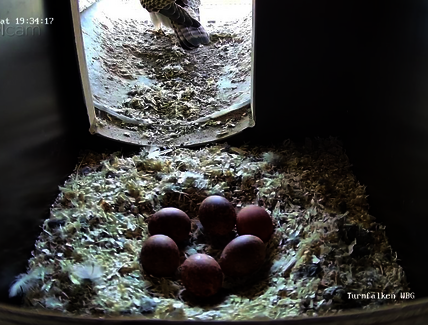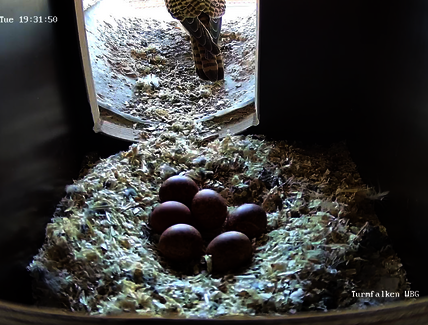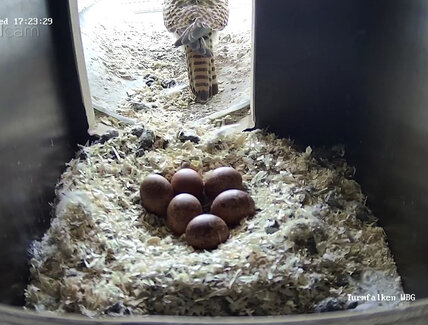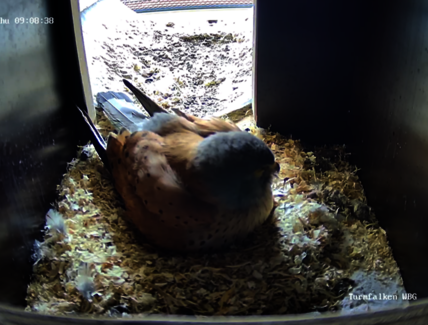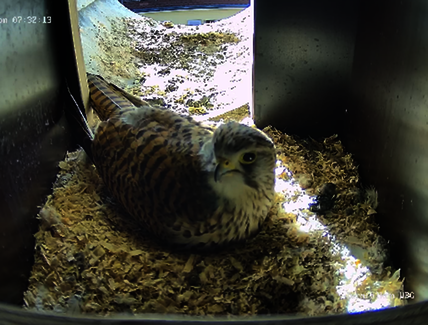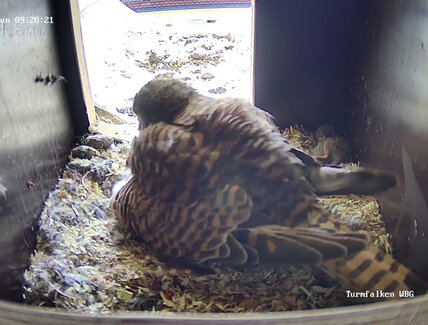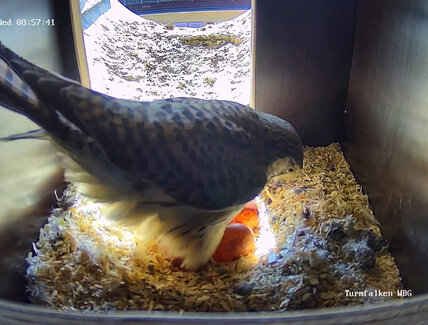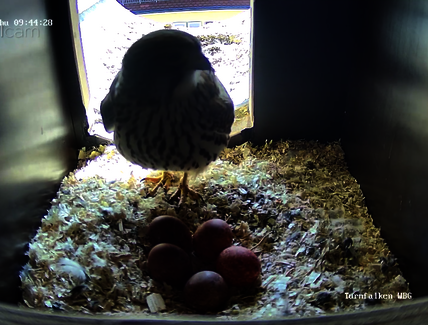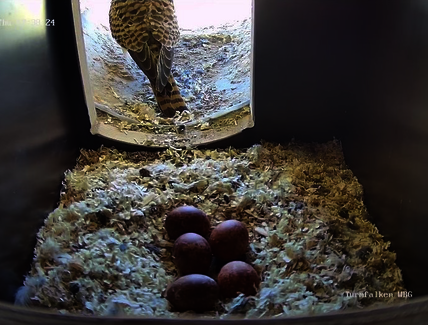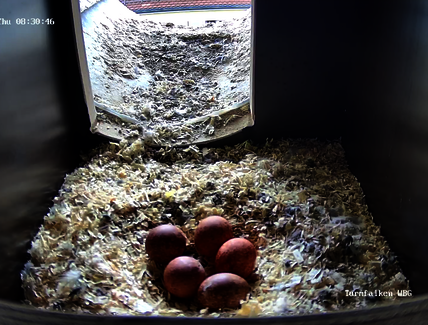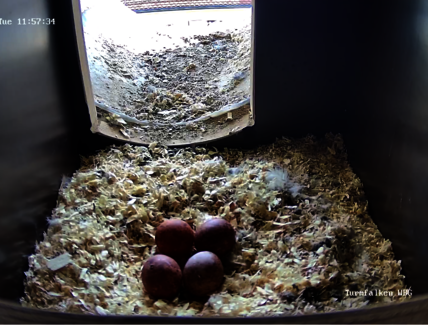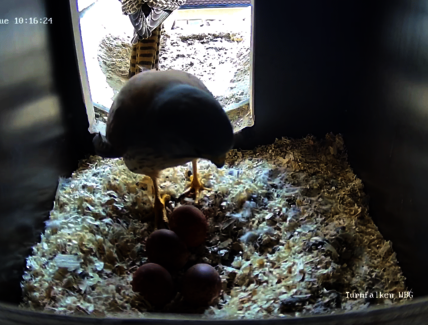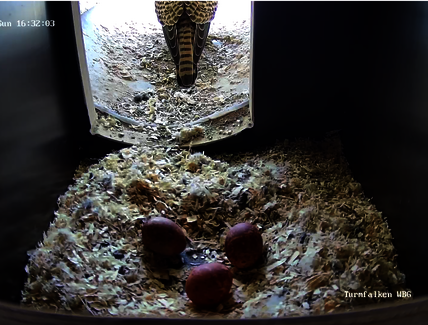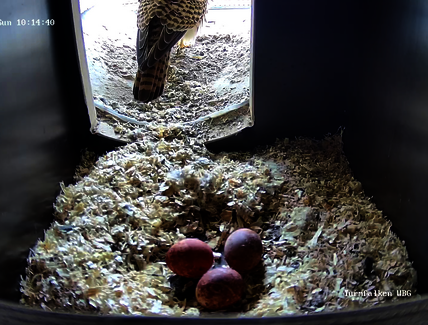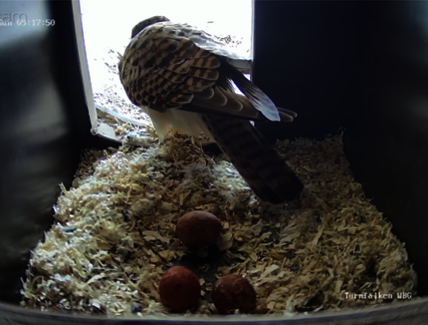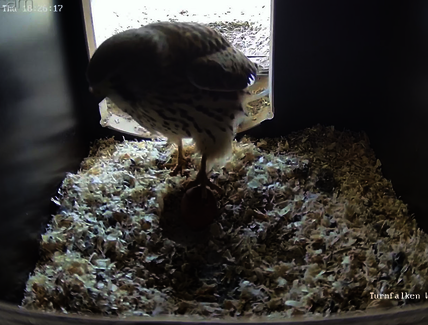Review of the year 2024
THE 2024 BREEDING SEASON AT A GLANCE
A magpie approaches the unguarded nest and steals one egg after another. The fact that the nest remained unguarded for so long and that the magpie had the opportunity to steal the eggs suggests that the female kestrel had abandoned the clutch.
This behaviour of the female confirmed once again that the eggs were unfertilised.
So, contrary to expectations, the 2024 breeding season has now come to an end. However, there is nothing we can do about the course of nature except look forward to the 2025 breeding season with hope and optimism.
On 1 May 2024, the fifth and final egg was laid and incubation began. For four weeks, everyone waited spellbound for the kestrels to hatch - unfortunately, they never did. According to our falcon expert, it is probably not unusual for the eggs of younger falcons - like our pair of falcons - not to be fertilised straight away.
A strange tercel visits the nest. The rightful landlord immediately rushes to the aid of the incubating female and chases the uninvited guest away.
The fifth and probably last kestrel egg for this breeding season has been laid. A short time later, the female is already incubating.
Since this morning, a fourth egg has been discovered in the kestrel nest. How many more eggs do you think there will be this season?
The third egg is in the nest, presumably laid in the early morning of April 27th.
After the first egg was laid two days ago, the second egg is now also in the kestrels' nest.
Today the female kestrel was attacked by a crow that wanted to steal its prey, a mouse. The female tried to defend herself, her prey and her freshly laid egg by making loud noises.
The crow had already stolen their eggs and food last year when pigeons were nesting there. The crow has apparently memorized the location and is now trying to steal the food from the kestrel pair.
Today at about 01:30 the female kestrel laid her first egg.
Now that the falcons have been spotted mating more often, it remains to be seen whether and how many eggs will be laid this year.
A female appears at the nest box for the first time. The tercel immediately lures her into the box and the female looks around.
The kestrel has been visiting the nesting box regularly for some time now. Today, the tercel brought a captured mouse to the potential nest to attract a female.
The kestrel repeatedly appears at the nest box and prepares a nesting hollow.
The tercel shows up at the nesting box for the first time and lingers for a few minutes. We are delighted that the kestrels have found their place in the nesting box again this year.
2023 Annual Review
THE 2023 BREEDING SEASON AT A GLANCE
We have waited and hoped for a long time - although the kestrel couple often showed up at the nesting site at the beginning, the kestrel nest unfortunately remained empty at the end. Even though a kestrel showed up at the nesting site again today, unfortunately we could not see any chicks growing up.
We hope for next year!
The kestrels have been visiting the nesting site more frequently lately and have already prepared a visible nesting hollow. More often than the female, the tercel shows itself and calls for the female. Currently it is still very cold outside and, like last year, now is the time to wait and see. Towards the end of April, both kestrels should show themselves more and more often at the breeding site. For comparison: Last year, the mating took place on 20 April.
The kestrel has been showing up regularly at the nest box lately - most recently today around 11 am. Having already prepared the nesting site, he calls the female. It is very likely that she is in the immediate vicinity.
The kestrel is back in the nest box and is preparing a nest hollow on the back of the box.
For some time now, the kestrel has been exploring its potential new home. To protect it from pigeons, a net can currently be seen in the livestream.
See how the kestrel defends its new territory against uninvited guests.
However, the net will be taken down again soon, as the kestrel was already completely inside the box and irritations should be avoided.
Technical and species conservation support: gruenstifter / gruenshoppen
2022 ANNUAL REVIEW
THE 2022 BREEDING SEASON AT A GLANCE
All you see is an empty nest? That’s because our kestrel chicks have just fledged. They regularly return to the nest to feed or rest. In the meantime, they are busy practising flying.
If you spot the young ones on one of their exploratory flights around Mögeldorf, please feel free to send us a photo by e-mail.
It didn’t take long. Now the second kestrel chick has ventured out of the nesting box and first of all inspected the new outdoor camera.
There were only two left! The first kestrel chick fledged today. The other two will follow in the coming days.
The young kestrels will probably stay in the nest until next week and will be provided with food by their parents (total nestling period approx. 30 days). After that, they’ll start fledging and will be provided with food for another 30 days. At first, they’ll be taught to hunt in groups and later on their own. With a bit of luck, you may see several young kestrels hunting or doing their first hunting exercises in the area in the coming weeks.
After the young kestrels have fledged, we would be delighted if you could share your sightings of the kestrels with us at info@wbg.nuernberg.de.
The kestrel chicks are almost 3 weeks old and the first “pennacious feathers”, which will later make up the coat, are already growing out of the downy plumage.
Now that the first hurdles have been overcome and they are well fed, they begin their first wing beats as a dry run for flying. The nesting box with the ledge offers enough space for these young birds to practice. Meanwhile, the young falcons are often seen with their beaks open. This serves to release heat in the warm temperatures.
The kestrel chicks continue to be fed, but starting in the second week they are fed less often than before.
The third chick has now hatched at a sunny 35 degrees. This chick also seems to be thriving.
Now, the second chick hatched in the morning hours. Both chicks seems to be doing well. Now we’re curious to see when the third egg will hatch.
Our pair of kestrels has finally had offspring. The first chick hatched around noon. We hope that the second chick will hatch soon.
The fact that the outdoor camera is not a disturbing factor can be seen in the recent behaviour of the tercel, which has been using it as a perch in front of its nest.
Meanwhile, the female is breeding as the tercel regularly brings it prey. In the early stages of breeding, the female likes to leave the nest for a short time to feed. Then the tercel takes over keeping the eggs warm.
The third egg is here. It was probably laid in the night from the 21st to the 22nd of May. How many eggs do you think will follow?
The second egg was laid in the night from Tuesday to Wednesday at about 10:00 p.m. Before that, the tercel brought a lizard for dinner.
The eggs are not immediately incubated throughout. Only when the clutch is (almost) complete will the female incubate continuously. This ensures that the young hatch as close together as possible.
The long wait has come to an end: The first egg was laid on May 15th at around 2:00 p.m.
Now that the kestrels have mated several times last week, it can be assumed that the egg-laying is imminent. The female is currently spending more time at the nest site, which is also a good sign.
As already suspected at the beginning of the season, it’s highly likely that the tercel first had to convince a new female of its nesting site. This could be the reason for the delayed egg deposition this year.
The pair of kestrels inspects their new home. If the kestrels are not visible in the live camera at the moment, both have probably flown out. In the meantime, you can watch videos of the latest events >> here.
After the mating of the kestrels, it now remains to be seen whether eggs will be laid this year, and if so, how many. In 2021, 6 young birds were raised.
Over Easter, the tercel has successfully wooed a new female. On Easter Sunday, it lured the female kestrel to the home with a gift of prey, and yesterday it moved in after the tercel had also formed the nest hollow. Now we’re hopeful and curious to see when the first eggs will be laid.
Today at noon around 10:00 a.m., two kestrels – one male and one female – could be seen again for a short moment on our live stream.
Here you can see the tercel looking for its potential mate.
Around noon, the tercel was seen again at the nesting box. The kestrel can now be seen more often after not being there for some time.
The fact that there is still no female to be seen is a bit disconcerting - but there’s still enough time for the male to attract a new female to its home.
You can see the tercel on its arrival in this video.
Here, the kestrel is chasing away two pigeons that have made themselves comfortable in its nesting box.
There’s an unusually low level of activity in the nesting box at the moment. The tercel has tried to lure the female with food more often in recent weeks, but so far without success. The gruenstifter experts have raised the concern that something might have happened to the female. Of course, the bad weather and falling temperatures are also not favourable and could have an effect on its arrival.
For the sake of comparison: Last year, the final transfer of prey in the box took place on 31 March 2021.
We’re hoping for the best!
The male kestrel has found its way to the wbg nesting box and is mainly inspecting the new outdoor camera. Thanks to it, we are given a view of the kestrel as it lingers in front of the nesting box, enjoying the view into the distance.
After our kestrels delighted so many of you last year, we want to give you an improved view of the wbg kestrels this year. To this end, we’ve installed a new outdoor camera. Now we’re just waiting for the arrival of the kestrels.
Kestrels originally breed in rocks and, in Franconian Switzerland, for example, they choose rock ledges or small rock caves as breeding sites. Over many years, they’ve adopted human habitations as “artificial rocks” and now also look for ledges, niches or caves in our cities.
A kestrel nesting box imitates a particularly optimal cavity in a rock and does not normally need to be cleaned regularly. It’s advisable to remove coarse soiling after approx. 3 - 5 years.
The falcon nesting box at the Imperial Castle of Nuremberg is only “cleaned” to determine which birds the peregrine has killed on the basis of the feathers.
The droppings on the walls of the boxes do not bother the falcons. Removing them would be more likely to cause confusion.
Technical and species conservation support: gruenstifter / gruenshoppen
2021 ANNUAL REVIEW
THE 2021 BREEDING SEASON AT A GLANCE
The time really flew by! The kestrels have all flown away in the meantime. We are therefore switching off the live image from the webcam. We’ve captured some of the most beautiful kestrel moments from the breeding season for you in the above video.
We thank you for your interest and hope that not only the kestrels will return next year, but also that you will remain loyal to us as interested observers!
All you see is an empty nest? That’s because our kestrel chicks have just fledged. They regularly return to the nest to feed or rest. In the meantime, they are busy practising flying.
If you spot the young ones on one of their exploratory flights around Mögeldorf, please feel free to send us a photo by e-mail.
The young kestrels will probably stay in the nest until next week /22/23 June) and will be provided with food by their parents (total nestling period approx. 30 days). After that, they’ll start fledging and will be provided with food for another 30 days. At first, they’ll be taught to hunt in groups and later on their own. With a bit of luck, you may see several young kestrels hunting or doing their first hunting exercises in the area in the coming weeks.
After the young kestrels have fledged, we would be delighted if you could share your sightings of the kestrels with us.
We would like to thank all visitors to our kestrel page. Since the start of the livestream, 150,000 viewers have tuned in to watch our kestrels raising their chicks.
In addition, we have received over 160 submissions to our inbox with pictures and videos from the livestream. It makes us happy to see that we reach so many viewers with our kestrels and that they’re also so enthusiastic about the bird family.
The kestrel chicks are about 3 weeks old and the first pennacious feathers, which will later make up the coat, are already growing out of the downy plumage.
After the first hurdles have been overcome, they begin their first wing beats as a dry run for flying. The nesting box with the ledge offers enough space for these young birds to practice. Meanwhile, the young falcons are often seen with their beaks open. This serves to release heat in the warm temperatures.
In the following days, the tercel will continue to do the hunting and bring the prey for the young and the female. The mother “broods”* and takes care of the young. All six young birds are currently being cared for.
If the young birds are left alone for a short time, they warm each other and form a pyramid of warmth. After only about 8 days, the second, darker plumage is already forming.
*(Brooding: The breeding birds take their offspring under their wings to protect them from cooling down)
Our livestream is now finally available in full screen mode. Just click on the full screen mode icon at the bottom right of the screen.
In the past weeks, we’ve received countless pictures, videos and text messages from users. We’d like to take this opportunity to thank all of you.
We’ve already shared some videos and pictures on our social media channels. We’re happy to see that the livestream is reaching so many people and that they’re watching enthusiastically.
We continue to follow the development of the chicks with excitement and are glad to have you with us.
As of Saturday afternoon, our kestrel family is complete. The sixth chick hatched around 2:00 p.m.
The fifth of our kestrel chicks hatched on Friday evening around 7:00 p.m.
The fourth chick hatched around 10:30 a.m. The mother first had to sort herself out a bit, but now it’s found the right position to warm all four chicks properly.
A second and a third kestrel chick saw the light of day during the night of May 19th to May 20th. Shortly afterwards, the second chick pecked its way through the shell between 5:45 a.m. and 6:00 a.m., followed by the third chick between 7:00 a.m. and 7:30 a.m.
The first chick hatched on 19 May 2021. At 2:20 p.m., it pecked its way out of the shell. The mother had already been very restless since morning, which is always a sure sign that something’s about to happen. You can watch the first chick hatch in the video.
Shortly after its birth, the chick is already being provided with a gift of food by its parents. You can see more in the following video.
The female does most of the brooding work. The tercel provides the female with food during this time. While the female eats at her feeding site, the male briefly takes over the brooding. During the brood change, the eggs can be examined more closely for a short moment. This could happen at the beginning of next week, around the 18th of May. When the shell changes visibly, the first chick may already be pecking its way through the eggshell.
Kinderhaus Rückenwind in Nuremberg was industriously engaged in handicrafts and painting. The main reason for this was their project week on the topic of kestrels and peregrine falcons, in which the children of the “Sun Group” learned all about birds of prey. Thanks to the webcam installed in the nesting box, they were able to watch the kestrels at close range and follow what was happening live on site. They, too, can hardly wait for the chicks to hatch and have been watching the wbg kestrels with great excitement. Imitators are expressly welcome!
It takes between 28 and 31 days for chicks to hatch from the eggs. In the case of our kestrels, this could be around the 18th of May. The female broods most of the time. Only during the female’s meals does the tercel take over the brooding. During the breeding season, the tercel hunts for itself and for the female.
Many eggs - good conditions!
If the clutch contains 6, or in rare cases even 7 eggs, this means that the conditions are optimal. This applies mainly to the food supply, but also depends on the quality of the nesting site.
Is the nesting box big enough for 6 young birds?
The nesting box of our kestrel pair was made by a specialist company according to species protection specifications of NABU (Naturschutzbund Deutschland e.V.). The former nesting space (in the last few years, breeding only took place on the window ledge) has been significantly enlarged by the new box and now offers a protected retreat and a spacious landing zone. For example, food can be delivered or, later on, young flight muscles can be trained on the now unobstructed window ledge. By the way, if the nesting box is too large, the kestrel’s territory may be lost, as the much larger peregrine falcon, for example, may take possession of it.
The kestrel female laid a fourth egg on 24 April 2021 at around 10:30 a.m.
The fifth egg is here! The female kestrel laid a fifth egg this morning around 7:00 a.m.
A fourth egg was laid on 20 April 2021 at around 7:15 a.m.
On the 18th of April at about 5:45 a.m., our kestrel laid the third egg.
Our female kestrel laid its second egg on April 15 at 10:52 p.m.
How many eggs does a female kestrel lay?
The female kestrel usually lays four to six eggs (ochre/brown-spotted) in mid/late-April. The eggs are laid “in series”. This means that there is a break of one to a maximum of three days between each egg laying. The number of eggs depends on the food supply in the territory and on the kestrels’ experience.
Why are the eggs not incubated yet?
To ensure that the young hatch at the same time or in short intervals, incubation does not begin until about three eggs have been laid. The eggs then need a temperature of about 38 °C. During the incubation period, the female has a featherless area on her underside that is well supplied with blood. This allows direct heat transfer to the eggs.
Our female kestrel laid the first egg on the 13th of April at 4:10 p.m. Shortly afterwards, the male also joined her. Now we can look forward to seeing when the first young hatch.
The male entices its mate with another mating gift:
>> To the video
Shortly afterwards he prepares the brood hollow:
>> To the video
How can you tell male and female apart? The male is clearly recognisable by its grey head and the diamond-shaped black spots on its brown plumage. The female, on the other hand, has a light brown head and back with a black pattern.
>> To the video
In the following week, the male kestrel showed off its new home to the female, enticed the female with gifts of food, and performed courtship displays. Since then, both have been coming regularly and you can already see how the nest is being prepared. Now it remains to be seen how many eggs will be laid this year.
On the weekend of 20-21 March 2021, the male visited for the first time briefly to inspect its new nest. Starting on the 22nd of March, the length of stay increased steadily.
>> To the video
In the summer of 2020, an attentive resident of our housing complex in Mögeldorf contacted us and informed us that kestrels were nesting in a property. As it turned out, a pair of birds of prey had already moved into a window niche in 2019 and laid and hatched several eggs there. This was then repeated in 2020. When one of the birds crashed with minor injuries, it was determined that they were kestrels.
Technical and species conservation support: gruenstifter / gruenshoppen




